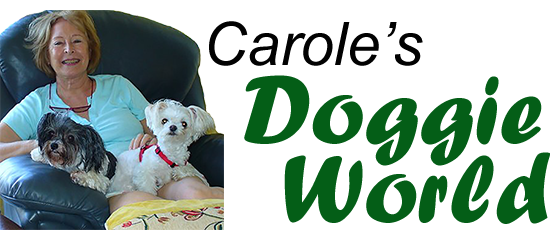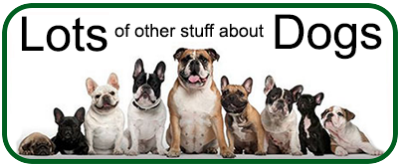Is your dog safe under anesthesia?
Specific questions you should ask
your vet before your dog undergoes anesthesia
Is your dog safe under anesthesia? | Ask specific questions | An example of safe protocols for your pet | Admission | Pre-anaesthetic routine | General
Physical examination | Pre anaesthetc medications and fluids
Pre-anaesthetic testing (check list)
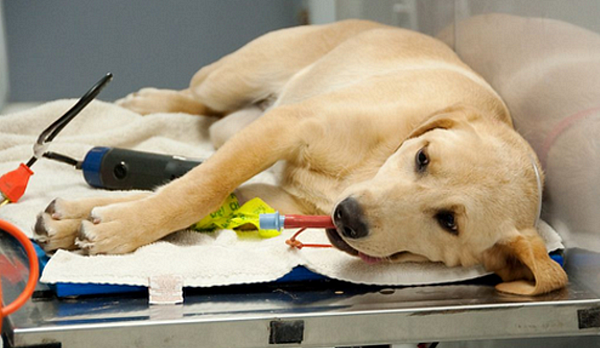
Is your dog safe under anesthesia?
A provocative question? Yes.
But important and timely, because it is one that many pet parents really worry about when their precious pet is facing surgery.
Over the last decade or so, there have been huge advances made in veterinary medicine and anesthesia knowledge, along with anesthesia monitoring; and also, the expectations by pet parents that their dogs will be well cared for whilst undergoing surgery.
But. . there are big variations in individual veterinary practices.
Before your dog undergoes surgery, if you have any misgivings about the anaesthetic procedure involved its a good idea to make an appointment with your vet, and express your concerns. Your vet will welcome any question you may have and will want to put your mind at rest. Having satisfied clients is all part of running a successful veterinary practice.
Here's a guide to the type of questions you may care to ask depending on how old he or she is and their past medical history.
Question one - who performs the anesthesia at the practice?
Question two - is water withheld from your pet? if the clinical staff suggest this prior to surgery, go elsewhere.
Question three - is food withheld longer than four hours if your pet is under four months of age? For young dogs low blood sugar is a huge concern, so they should only have food withheld for a maximum of four hours, and then offered food after surgery.
Question four - will you dog be given pre-surgical physical exam (PE) prior to having surgery?
Question five - is monitoring attached prior to the induction of anesthesia? Your pet may have low blood pressure, or be low in oxygen, and knowing this ahead of time allows your vet to delay or adjust the anesthesia accordingly.
Question six - is your pet is old? does he or she have a compromised heart, or lungs or other organs? If so, will your vet pre-oygenate by administering 100% oxygen before he or she is intubated? This procedure ensures that your dog will not go for any period of time without adequate oxygen, thus making its anaesthetic procedure far safer.
Question seven - what equipment does your vet clinic use for monitoring during surgery? e.g. you are entitled to expect:
- Your dog's blood pressure to be monitored
- A pulse oximeter to be used, and
- That an anesthesia record sheet is part of your dog's surgical procedure
Question eight - what type of anesthesia will be use for the:
- First part of your pet's anesthesia (pre-medication)?
- Induction of anesthesia with the IV injectables?
- What type of anesthetic gas is used to maintain anesthesia during surgery?
Question nine - Does your vet use a pre-anaesthetic list?. There is an outline of this Pre-anaesthetic testing (check list) form at the end of this post for your reference.
Question ten - remember that monitors don't tell your vet everything. Will you vet be checking the following throughout your pet's surgery?
- Body temperature
- Adequate blood pressure
- Cardiac arrhythmias

Question eleven - what happens if your dog's temperature drops? and what procedures are in place to keep your dog warm during surgery? Does your vet use the following?
- IV fluid warmers
- Safe heating pads (ie those that use warm water, not electric heating pads)
- Warmed up saline if flushing body cavities
Question twelve - does you vet recommend adequate pain control during and after surgery?
Question thirteen - will your dog be given IV fluids throughout the whole procedure?
Question fourteen - Will your pet be monitored after surgery? Your dog's procedure is not finished until he or she can comfortably breath on their own in their recovery cage.
An example of safe protocols for your pet
Pre-anesthetic
- Hydromorphone
- Acepromazine
- Hydropmorphine alone for older/debilitated patients
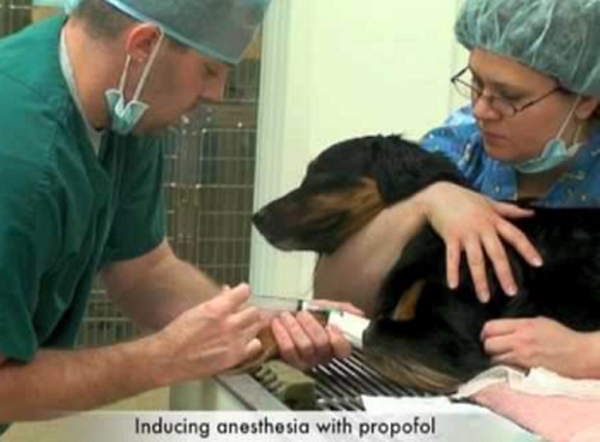
Induction anesthetic
- Ketamine/Valium for healthy, uncompromised patients
- Propofol or Aflaxan for older, compromised patients
- Aflaxan is a new injectable anesthesia drug with less chance of your pet suffering from apnea (not breathing), while being given. Regardless, the key is to give a lower calculated percent of the drug initially (e.g. 25%) to avoid the apnea.
Maintenance anesthetic
Gas anesthesia with Isoflurane following intubation.
The following is a pre-anesthetic checklist that gives you an indication of the type of form you can expect your vet will use, courtesy of Veterinary Anesthesia & Analgesia Support (VASG).
Admission
1) A pre-surgical review of your pet's medical history should be reviewed for completeness prior to admission.
2) It's recommended that a vet or licensed vet tech supervises your dog's admission for surgery. A properly trained non-professional is quite capable of handling this process but we recommend that a licensed professional be on hand to assist this individual should you have any questions or concerns.
3) An admission checklist or questionnaire can be a valuable tool to insure a thorough assessment of your dog. An example Pre-anaesthetic testing (check list) is included at the end of this article.
4) Here is a list of do's and don't you should be aware of prior to admission, together with a list of important details you should divulge to your vet upon admission.
- Food should be withheld for 12 hours prior to admission in normal dogs over the age of four months
- For dogs less than four months of age, hypoglycemia is a significant concern, therefore it is recommended withholding food for only four hours prior to anesthesia helps to minimise this concern
- You should never withhold water from your pet prior to admission irrespective of the age of your dog
- Any medications or supplements you have been giving to your dog within seven days prior to surgery should be divulged to your vet.
- If your dog has developed any new health concerns that your vet is not aware of, you should discuss these with your vet prior to admission
- If your dog has experienced any previous anesthetic problems you should review these with your vet
- You should advise your vet if your pet has an history of:
* excessive stress when kenneled
* chewing at stitches or bandages
* difficulties when activity is restricted, and
* if you know you are going to have difficulty maintaining you dog in a clean and dry environment during his or her recovery.
5) Growths - if your dog is being admitted for the removal of a small growth/s, make sure you show the admitting staff where they are. This will enable the growths to be marked with a marker for easy identification and shaving of the area.
6) You should received an accurate Estimate and Surgical Release Form from your vet clinic, you need to read the detail carefully before you are comfortable signing off as your dog's owner.
Keep updated with all that's
right for your best friend!
click on this link
to subscribe to our free mailing list.

- Your dog will be weighed and his or her weight recorded.
- An anesthetic record will be prepared for your dog for reference during surgery
- Similarly an emergency drug reference sheet will be kept handy at all times.
- Some computer systems have an emergency drug component built into their software, others don't
- The American Animal Hospital Association (AAHA) Library has such a reference sheet, if you would like to sight a current one
Physical examination (PE)
- A pre-anesthetic physical examination will be carried out and the information entered into your dog's records
- This examination should be performed by a licensed tech or a staff vet
- Each vet clinic will have their own guidelines as to when the PE is done. Generally speaking, the PE is shorter for younger dogs with no health concerns and longer when dealing with geriatric and unhealthy dogs
- Some States may require this PE be performed by a DVM and may stipulate the timing of this PE. Make yourself familiar with your State's requirements. It is not possible to detail State to State variation in this reference
- A final categorization of your dog will be made based upon the following guidelines:
*Excellent - dogs with no organic disease or in whom the disease is localised and is causing no systemic disturbance, e.g. a healthy three year old neutered male dog
*Good - a dog with mild systemic disturbances which may or may not be associated with the planned procedure, e.g.a mildly anemic patient, obese patient, geriatric patient
*Fair - a dog with moderate systemic disturbances which may or may not be associated with the planned procedure and which usually interferes with normal activity but is not incapacitating, e.g. mitral valve insufficiency, moderate anemia
*Poor - a dog with extreme systemic disturbances which are incapacitating and are a constant threat to life and seriously interferes with the dog's normal function, e.g. uncompensated mitral valve insufficiency, severe pneumothorax
*Critical - a dog presenting in a moribund condition, and is not expected to survive without immediate surgery,and even them its chances of survival are slim e.g. an acute, severe intra-abdominal hemorrhage.
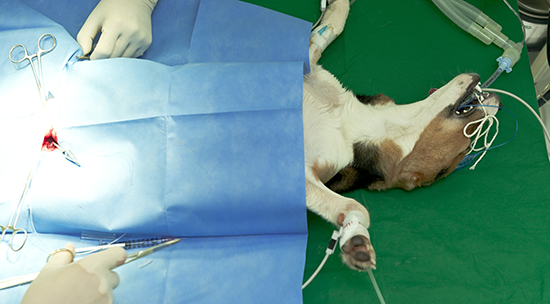
Pre anaesthetc medications and fluids
Your dog's pre-anesthetic medication decisions should have been explained to you by your vet when you admitted your pet.
When your pet is about to undergo surgery it is important that he or she should be provided with an experience that minimises stress, anxiety and discomfort. This not only makes their stay more pleasant, but reducing stress and anxiety is an important component in the analgesic process.
The selection of medications given should be based on the individual needs of your dog and all of the following details will be factored in when your vet makes this decision, including:
- Species
- Size
- Age
- Attitude
- Health status
- The safety of the clinical staff
The timing of the administration of the pre-anesthetic meditation in important, and in general the pre-anesthetic medications should be administered:
- 30 to 45 minutes prior to the induction of anesthesia if given subcutaneously
- 15 to 20 minutes prior to the induction of anesthesia if given intramuscularly
Ideally it is best to wait until the pre-anesthetic medications have taken effect before inserting your dogs's IV catheter. And it is preferable to have an intravenous catheter securely placed prior to anesthetic induction.
Normally, the catheter should remain in place until your dog is recovered to a point that no further need for IV medication or fluid support is anticipated.
However, due to the fractious nature of some dogs, it may be necessary to insert the catheter immediately after anesthetic induction and remove it prior to full anesthetic recovery in order to protect the safety of the clinical staff.
IV fluids should be administered through an infusion pump whenever available. This is especially important for small patients and cardiac patients for whom fluid overload is a much more likely complication.
If an infusion pump is not available, a micro-dripset should be used when administering fluids to dogs under 15 pounds or dogs requiring more control over fluid rates.
Pre-anaesthetic testing (check list)
The decision regarding when to perform pre-anesthetic tests and which tests to include is a decision that needs to be addressed individually by each individual veterinary clinic.
Pre-anesthetic testing is a consideration to allow detection of underlying disorders that may influence the management of:
- Your dog, or influence the prognosis associated with any given disorder.
- The debate as to the extent and timing of such testing.
- Blood samples, which should be drawn prior to premeds if it is not excessively stressful to your dog. This is because premeds may influence the results of certain tests e.g. accepromazine can decrease patient packed cell volume (PCV) up to 30%
- Whether blood collection is possible without premeds. If it is too stressful for your dog then it is best if the premeds are given, and blood samples are collected after a wait period of 15 to 20 minutes.
- Of lab results, to include labeling to indicate when samples were collected from your dog, e.g. either before or after the administration of premeds, especially if acepromazine has been used.
Reference: Dr. Andrew Jones VMD - drandrew@theonlinevet.com
This article and information forms part of the Carole's Doggie World Holistic Library and is presented for informational purposes only.The information is not intended to be a substitute for visits to your local vet. Instead, the content offers the reader information researched and written by Carole Curtis for www.carolesdoggieworld.com
